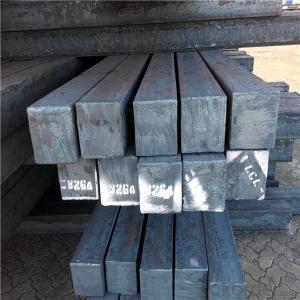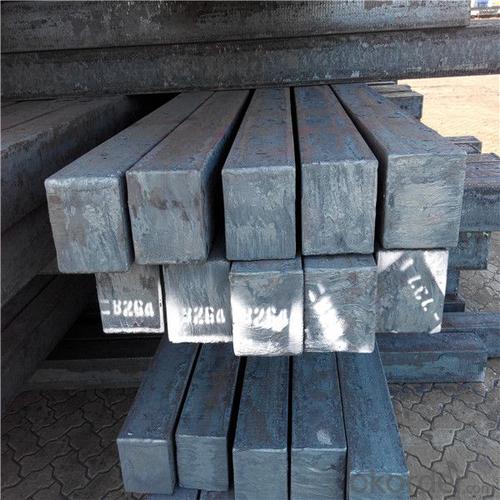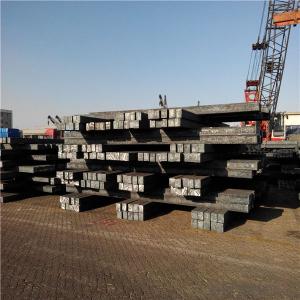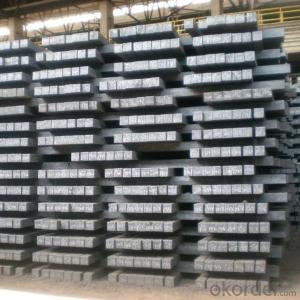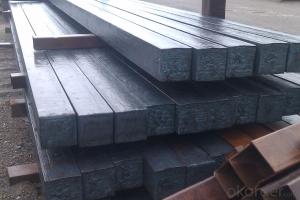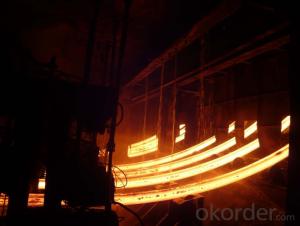Prime concast square steel billet in different size
- Loading Port:
- China main port
- Payment Terms:
- TT OR LC
- Min Order Qty:
- 1000 m.t.
- Supply Capability:
- 18312 m.t./month
OKorder Service Pledge
OKorder Financial Service
You Might Also Like
Specification
Steel billet :
Steel billet(ingot) by cogging or breakdown of semi-finished products, is the raw material of all kinds of steel mill. Billet section of square, round, flat,
rectangular and abnormity of several kinds of, mainly related to the shape of rolled products.
The billet is mainly divided into two kinds from the shape:
Slab: cross section width and height of the ratio of the larger, mainly used for rolling plate.
Billet: equal cross section width and height, or a huge difference, mainly used for rolling steel, wire rod. ,
Gade:
Standard | C(%) | Mn(%) | S(%) | P(%) | Si(%) |
Q195 | ≤0.12 | ≤0.50 | ≤0.040 | ≤0.035 | ≤0.30 |
Q235 | ≤0.20 | ≤1.40 | ≤0.045 | ≤0.045 | ≤0.35 |
Q275 | ≤0.22 | ≤1.50 | ≤0.045 | ≤0.045 | ≤0.35 |
20MnSi | 0.17-0.25 | 1.2-1.6 | ≤ 0.050 | ≤ 0.050 | 0.40-0.80 |
3SP | 0.14-0.22 | 0.40-0.85 | ≤ 0.050 | ≤ 0.040 | 0.05-0.15 |
5SP | 0.28-0.37 | 0.50-1.00 | ≤ 0.050 | ≤ 0.040 | 0.15-0.30 |
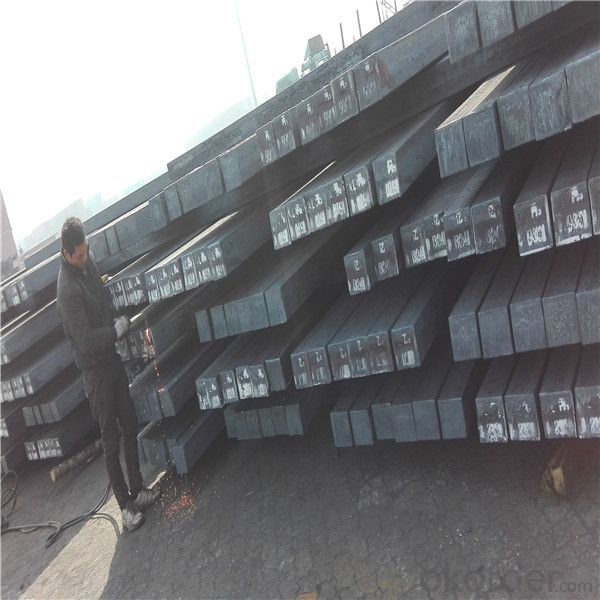
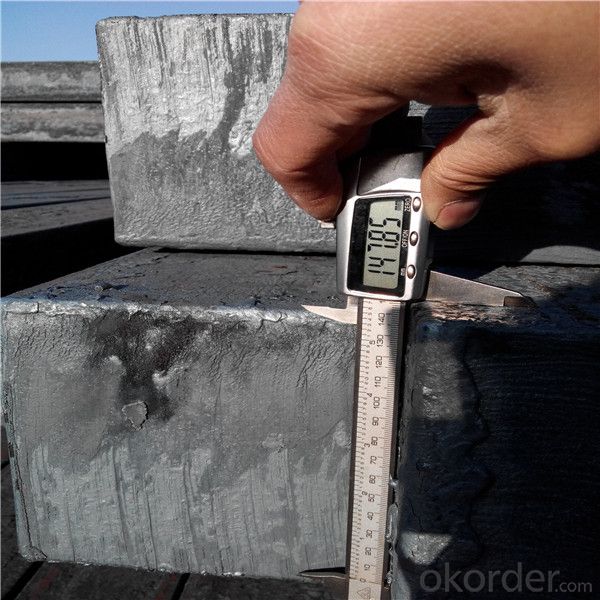
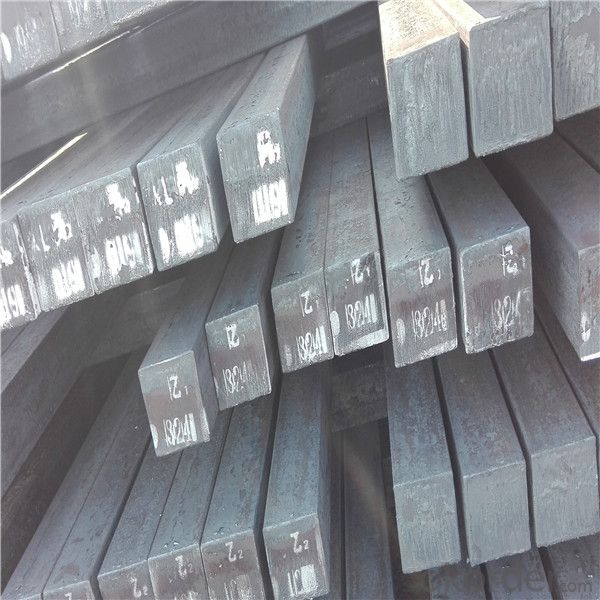
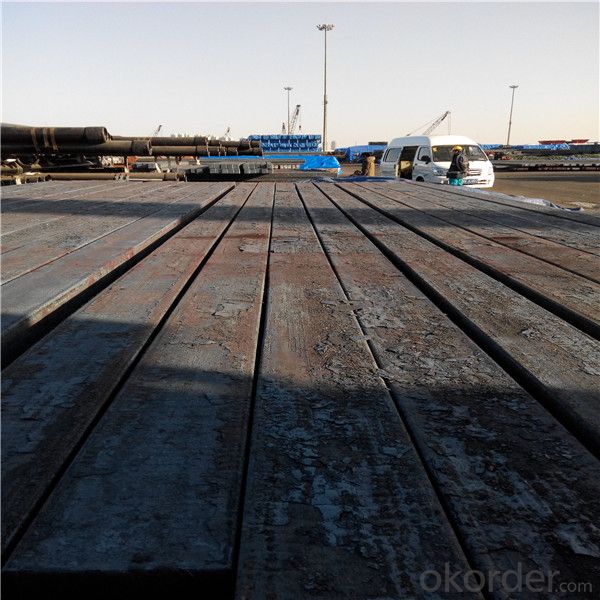
Our Advantage
* Professional Personnel of Steel Trading
* Strong Steel Industry Background
* Conveniently Geographic Location
Our Commitment
* Sincere, Practical, Efficient and Developing
* High Quality Steel Production
* Competitive Price and Timely Delivery
Packing :
Within 30 days
1.Standard export package
2.In bundles with steel strips
3.As the requirements of the customers
FAQ:
Q: How to get quotation?
A: When we receive your detailed enquiry, we will set the best price based on standard,
steel grade, outer diameter, wall thickness, quantity, country.
And we will send quotation to your mailbox.
Q:How to guarantee the quality of the products?
A:We have established the international advanced quality management system,every link from raw material
to final product we have strict quality test;We resolutely put an end to unqualified products flowing into the market.
At the same time, we will provide necessary follow-up service assurance.
Q:How long can we receive the product after purchase?
A :In the purchase of product within three working days, We will arrange the factory delivery as soon as possible.
The pecific time of receiving is related to the state and position of customers.
- Q: What are the potential applications of steel billets in the electronics aftermarket?
- Steel billets have limited applications in the electronics aftermarket due to their material properties. However, they can be used in certain components such as structural supports, mounting brackets, or enclosures that require high strength and durability.
- Q: How are steel billets different from steel ingots?
- Steel billets and steel ingots are both semi-finished steel products, but they differ in terms of their shape, size, and manufacturing process. Firstly, the shape of steel billets and steel ingots is different. Steel billets are typically square or rectangular in shape, with specific dimensions that are determined by the production requirements. On the other hand, steel ingots have a more irregular shape, often resembling a large block or loaf. The shape of the ingot is determined by the mold in which it is cast. Secondly, the size of steel billets and steel ingots also varies. Steel billets are generally smaller in size compared to ingots. Billets are typically produced in smaller cross-sectional areas and lengths, making them more suitable for further processing. Steel ingots, on the other hand, are larger and heavier, as they are cast in molds that can accommodate a greater volume of molten steel. Lastly, the manufacturing process for steel billets and steel ingots differs. Steel billets are typically produced through a process called continuous casting, where molten steel is poured into a water-cooled mold to solidify into the desired shape. This process allows for a more controlled and efficient production of billets. On the other hand, steel ingots are generally produced through casting in open or closed molds, where the molten steel is poured and left to solidify. This process is often slower and less precise compared to continuous casting. In summary, steel billets and steel ingots differ in terms of their shape, size, and manufacturing process. Billets are square or rectangular in shape, smaller in size, and produced through continuous casting, while ingots have an irregular shape, larger in size, and produced through casting in molds. Both products serve as essential raw materials for the production of various steel products.
- Q: How are steel billets used in the production of marine components?
- Steel billets are an essential component in the manufacturing process of marine parts, including ship propellers, hulls, and offshore structures. These components must possess high levels of strength, durability, and resistance to corrosion in order to endure the harsh conditions of the marine environment. Steel billets are essentially semi-finished products that take the form of solid rectangles. They are typically created by pouring liquid steel into molds and allowing it to cool and solidify. These billets are then utilized as raw materials in the production of various marine components. To begin the production of marine components, steel billets are first heated to a specific temperature in order to soften the material. This process, known as hot rolling, enables the billets to be shaped into different forms such as bars, rods, or sheets, depending on the specific requirements of the component being manufactured. Once the desired shape is achieved, the steel billets undergo additional processes such as forging, machining, and welding. Forging involves applying pressure to the heated billets to mold them into the desired marine component. Machining is then performed to refine the shape, size, and surface finish of the component, ensuring it meets the required specifications. Welding is used to join different steel billets or sections together to create larger marine components, such as ship hulls. The utilization of steel billets in the production of marine components offers numerous advantages. Steel is a robust and durable material that can withstand the extreme forces and conditions encountered in the marine environment. Furthermore, steel possesses excellent corrosion resistance properties, which are vital for marine components exposed to saltwater and other corrosive agents. In conclusion, steel billets play a critical role in the manufacturing of marine components. They serve as the raw materials that are shaped, refined, and joined together to create strong, durable, and corrosion-resistant components for ships, offshore structures, and other marine applications.
- Q: How are steel billets used in the manufacturing of furniture and fixtures?
- Steel billets are an essential component in the manufacturing of furniture and fixtures due to their versatility and durability. These billets, which are semi-finished metal products, serve as the raw material for creating various components of furniture and fixtures. One common use of steel billets in furniture manufacturing is for creating frames and structural supports. The billets are shaped and cut into specific dimensions to form the framework of chairs, tables, and other pieces of furniture. The strength and rigidity of steel make it a preferred choice for ensuring the stability and longevity of these products. In addition to frames, steel billets are used for producing hardware components of furniture and fixtures. This includes hinges, locks, drawer slides, and other mechanisms that require strength and precision. By using steel billets, manufacturers can ensure that these components can withstand the wear and tear associated with daily use. Steel billets are also utilized in the production of decorative elements in furniture and fixtures. They can be molded, bent, or welded into various shapes and designs to add aesthetic appeal to the final product. These decorative elements may include trimmings, accents, or ornamental details that enhance the overall appearance of furniture and fixtures. Furthermore, steel billets are often used in the manufacturing of fixtures such as shelving units, display racks, and storage systems. The durability and load-bearing capacity of steel make it an ideal material for constructing these items, ensuring that they can withstand heavy loads and provide long-term support. In summary, steel billets play a crucial role in the manufacturing of furniture and fixtures. They are used to create frames, hardware components, decorative elements, and various types of fixtures. Their strength, durability, and versatility make them an essential raw material for producing high-quality and long-lasting furniture and fixtures.
- Q: What are the specifications for tool steel billets used in the manufacturing of cutting tools?
- The specifications for tool steel billets used in the manufacturing of cutting tools can vary depending on the specific application and requirements. However, there are some general specifications that are commonly followed. 1. Composition: Tool steel billets are typically made from high-carbon alloy steels that contain elements such as chromium, molybdenum, vanadium, tungsten, and cobalt. These alloying elements enhance the hardness, wear resistance, toughness, and heat resistance of the tool steel. 2. Hardness: Tool steel billets are required to have a high hardness to withstand the demanding cutting conditions. The hardness is typically measured on the Rockwell C (HRC) scale, and it can range from 58 HRC to 65 HRC or even higher for certain applications. 3. Wear Resistance: Cutting tools are subjected to abrasive wear during operation. Therefore, tool steel billets are formulated to have excellent wear resistance properties to ensure a longer tool life. This is achieved by incorporating alloying elements that form carbides, such as chromium and vanadium, which increase the hardness and wear resistance of the tool steel. 4. Toughness: While hardness and wear resistance are important, tool steel billets must also possess sufficient toughness to withstand the high impact forces generated during cutting. High toughness ensures that the cutting tools do not fracture or chip easily, even under severe cutting conditions. 5. Heat Resistance: Cutting tools are often exposed to high temperatures during operation, especially in high-speed cutting applications. Tool steel billets must have good heat resistance to prevent softening or deformation at elevated temperatures. This is achieved by adding alloying elements like molybdenum and tungsten, which contribute to the heat resistance properties of the tool steel. 6. Machinability: Tool steel billets should have good machinability to enable the production of complex cutting tool geometries with high precision. Proper selection of alloying elements and heat treatment processes can enhance the machinability of tool steel billets. It is important to note that the specific specifications for tool steel billets may vary depending on the specific cutting tool application, the material being cut, and the machining conditions. Therefore, it is crucial to consult with the tool steel manufacturer or supplier to determine the exact specifications required for a particular cutting tool application.
- Q: What is the role of steel billets in the shipbuilding industry?
- The shipbuilding industry relies heavily on steel billets as they are the primary material used to build the structural components of ships. These billets, which are semi-finished steel products, are made by casting molten steel into rectangular shapes that can be further processed into various shipbuilding parts. Using steel billets in shipbuilding offers several advantages. Firstly, they are known for their high strength and durability, making them ideal for withstanding the intense stress and harsh conditions ships face, such as waves, corrosion, and extreme temperatures. This ensures the structural integrity and longevity of the vessel. In addition, steel billets have excellent weldability, which is crucial in shipbuilding as ships have numerous welded joints. The ease and reliability of welding steel billets allow for efficient and cost-effective construction methods, reducing both time and labor required. Furthermore, steel billets provide versatility in ship design. They can be easily shaped and fabricated into different forms and sizes, enabling shipbuilders to create complex structures that optimize space utilization and enhance functionality. This flexibility in design allows for the construction of various types of ships, from cargo vessels and tankers to cruise ships and naval vessels. Moreover, steel billets have excellent resistance to corrosion, which is essential for ships constantly operating in corrosive marine environments. The high-quality steel used in billets protects against rust and deterioration caused by seawater, ensuring the safety and longevity of the vessel. Overall, steel billets are crucial in shipbuilding as they provide the necessary strength, weldability, versatility, and corrosion resistance required for constructing durable and seaworthy ships. Their use as the primary raw material allows for the creation of reliable and efficient vessels capable of withstanding the challenging conditions of the maritime environment.
- Q: Can steel billets be used in the production of jewelry?
- Steel billets are typically not used in the production of jewelry due to their composition and properties. Steel is an alloy primarily composed of iron and carbon, with additional elements such as manganese, chromium, and nickel. This composition gives steel its strength and durability, making it ideal for various industrial applications, but not for jewelry production. Jewelry is often crafted from precious metals like gold, silver, and platinum, which possess unique characteristics that make them suitable for adornment. These metals are malleable, meaning they can be easily shaped and molded into intricate designs. Additionally, they have a lustrous appearance and are resistant to tarnishing or corrosion. Steel, on the other hand, is much harder and less ductile compared to precious metals. It cannot be easily manipulated into delicate and intricate shapes required for jewelry making. Furthermore, steel has a dull gray color, which does not provide the desired aesthetic appeal in jewelry. While it is technically possible to create jewelry using steel billets, it is not a common practice due to the aforementioned reasons. Steel is primarily used in industries where its high strength and durability are necessary, such as construction, automotive, and machinery manufacturing.
- Q: What are the common surface defects in steel billets during reheating?
- Several surface defects may occur during the reheating process of steel billets, which can negatively impact the quality and integrity of the final product. Some of the most common surface defects observed in steel billets during reheating are as follows: 1. Scale Formation: When steel billets are subjected to high temperatures, a layer of iron oxide, referred to as scale, can develop on the surface. Scale is brittle and can easily crack or flake off, resulting in a rough and uneven surface. 2. Decarburization: Exposing steel billets to high temperatures causes the loss of carbon from the surface, known as decarburization. This leads to a decrease in carbon content on the surface, making it susceptible to cracking, reduced hardness, and poor mechanical properties. 3. Surface Oxidation: During reheating, steel billets can undergo oxidation when exposed to oxygen in the air. This results in the formation of a thin layer of oxide on the surface, affecting the surface finish and potentially reducing the steel's corrosion resistance. 4. Overheating: If the reheating process causes localized melting or partial melting of the steel billets, it is referred to as overheating. This can lead to surface irregularities, such as pits, cracks, or blisters, compromising the integrity of the billets. 5. Hot Spots: Uneven heating of the steel billets can cause hot spots to form on the surface. These localized areas of excessive heat can result in surface defects like warping, cracking, scorching, or discoloration. 6. Surface Contamination: During reheating, steel billets may come into contact with contaminants such as dirt, oil, or other foreign materials. These contaminants can adhere to the surface, leading to surface defects like stains, pitting, or an uneven surface finish. 7. Thermal Shock: Rapid temperature changes during reheating can cause thermal shock, resulting in surface defects like cracks or distortions. This can occur when the steel billets are exposed to water or a cooling medium, or when there are significant temperature differences across the surface. To minimize these surface defects in steel billets during reheating, it is essential to employ proper heating techniques, control heating rates, and use protective coatings or atmospheres. Additionally, regular inspection and quality control measures can help identify and mitigate surface defects before they impact the final product's quality.
- Q: What are the main factors affecting the creep resistance of steel billets?
- The main factors affecting the creep resistance of steel billets are temperature, stress level, and alloy composition. Temperature plays a crucial role in determining the creep resistance of steel billets. As the temperature increases, the atomic diffusion within the material becomes more active, leading to enhanced creep deformation. Higher temperatures allow for more rapid grain growth and can result in the formation of voids and cracks, ultimately weakening the billet's resistance to creep. The stress level applied to the steel billet also significantly affects its creep resistance. Higher stresses increase the rate of creep, as they promote dislocation movement within the crystal lattice. Additionally, stress concentration at various defects, such as voids or impurities, can accelerate creep deformation. Therefore, controlling the stress level is essential in maintaining the creep resistance of steel billets. The alloy composition of the steel billet is another critical factor influencing its creep resistance. Different alloying elements can alter the microstructure of the material, affecting its creep properties. For example, elements like chromium, molybdenum, and vanadium can form stable carbides that hinder dislocation movement and improve creep resistance. Other elements, such as sulfur or phosphorus, can promote grain boundary sliding and reduce creep resistance. In summary, the creep resistance of steel billets is primarily influenced by temperature, stress level, and alloy composition. By carefully controlling these factors, manufacturers can produce steel billets with enhanced creep resistance, ensuring their suitability for various applications.
- Q: How are steel billets used in the energy and power generation industry?
- Steel billets are an essential component in the energy and power generation industry due to their strength, durability, and versatility. These cylindrical castings of steel are used in various applications within this industry. One of the primary uses of steel billets in the energy and power generation industry is for the construction of power plants and infrastructure. Billets are commonly used to manufacture heavy-duty equipment, such as turbines, generators, and boilers, which are crucial for converting various energy sources into electricity. The high strength and resilience of steel billets ensure that these structures can withstand the harsh operational conditions and maintain their integrity over an extended period. In addition to the construction of power plants, steel billets are also used in the manufacturing of transmission and distribution systems. These systems, including power lines, transformers, and substations, require sturdy materials to support the efficient transmission and distribution of electricity. Steel billets are often used to produce the poles, towers, and other structural components that form the backbone of these systems, ensuring their reliability and long-term functionality. Moreover, steel billets find application in the production of equipment used for renewable energy generation. For instance, in wind energy, billets are used to manufacture the towers on which wind turbines are mounted. These towers must withstand the forces exerted by wind and support the weight of the turbine, and steel billets provide the necessary strength and stability for this purpose. Furthermore, steel billets are employed in the fabrication of equipment for oil and gas exploration, extraction, and refining. In this industry, billets are utilized to produce pipes, valves, and other components that are essential for transporting and processing petroleum and natural gas. The robustness of steel billets ensures the integrity and safety of these systems, even in demanding conditions such as high-pressure and high-temperature environments. In summary, steel billets play a vital role in the energy and power generation industry by serving as the building blocks for the construction of power plants, transmission systems, renewable energy infrastructure, and oil and gas facilities. Their strength, durability, and versatility make them an indispensable material for ensuring the reliability, efficiency, and safety of these critical energy systems.
Send your message to us
Prime concast square steel billet in different size
- Loading Port:
- China main port
- Payment Terms:
- TT OR LC
- Min Order Qty:
- 1000 m.t.
- Supply Capability:
- 18312 m.t./month
OKorder Service Pledge
OKorder Financial Service
Similar products
Hot products
Hot Searches
Related keywords
